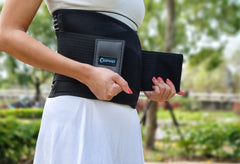
※This product is for daily maintenance, not for medical use.
What is a hunchback correction belt?
In today's technological age where people sit for long periods of time and stare at computers or mobile phones for long periods of time, a design was developed due to demand. It is an auxiliary device used to assist with hunchback problems. It is also called a posture correction belt, a posture corrector, etc., such as a backpack. way around the shoulders to provide support and reminder.
Wearing a hunchback brace is a process that requires patience. Results usually take some time to show, and length of wear is also a crucial consideration. During initial use, it is recommended to wear it for 15 to 30 minutes every day, and gradually increase the time to avoid discomfort to the body. Since the hunchback takes a long time to form, correction also takes a certain amount of time.
1. Frequency and time of use: The effect of wearing a hunchback correction belt depends on the frequency and time of use. It is recommended to use it for a short time each day initially and then gradually increase the time of use to avoid muscle fatigue or discomfort.
2. Pair it with other exercises: It may be difficult to achieve the desired effect with a hunchback correction belt alone, so it should be paired with corresponding exercises. Strengthening your back, abdominals and core muscles is an important part. Here are some exercises that may help correct your kyphosis:
Back stretches : Including sit-ups, back extensions and other exercises, which can help lengthen the back muscles and improve posture.
Abdominal training : Strengthening the abdominal muscles can support the spine and help maintain correct posture.
Core training : Includes exercises such as planks and bridges to help enhance core stability.
3. Correct sitting and standing postures: Not only should you maintain correct sitting and standing postures when wearing a hunchback correction belt, but you should also pay attention to maintaining good posture in daily life, so as to prevent the correction belt from becoming a dependence rather than a means of improving your hunchback.
4. Seek professional advice: If your hunchback problem is severe, it is recommended to seek the advice of a professional doctor or physiotherapist. They can evaluate your condition and provide more specific correction recommendations and exercise programs.

Generally, people on the Internet or in stores will recommend asking a doctor before choosing, but the fact is that if the hunchback is not very serious, most people will not go to the doctor for consultation. Instead, they will buy online. It seems to be 1. Cheap, 2. Sales volume is high, 3. Reviews are good, 4. Available. Brand of corrective straps, right?
Here are the following points for reference to choose the corrective belt that suits you:
1. Shoulder or waist: There are different models and designs of hunchback correction belts, including shoulder correction belts, waist correction belts, etc. Choose the appropriate model according to the specific location of your hunchback problem.
(The editor personally uses a shoulder correction belt, which is easy to carry and small in size. It is convenient for people who often use computers to carry it with them in their computer bags.)
2. Ensure adjustability: Generally, hunchback correction belts can be adjusted in size, which is very important to ensure appropriate support and comfort. It is recommended to check the bust size before purchasing and confirm with the seller whether it fits.
3. Consider comfort: Choose soft and breathable materials. Especially in the summer when the weather in Taiwan is hot and easy to sweat, breathability is relatively important.
4. Adaptation period: Before starting to use a hunchback correction belt, understand the importance of using the adaptation period. It may be necessary to use it for short periods of time initially and then gradually increase the time of use to avoid excessive fatigue or discomfort.
5. Know the limitations of use: Some people may not be suitable for using hunchback correction belts due to special physical conditions or health problems. If you have any doubts, it is recommended to seek professional advice before use.
The hunchback correction belt is an auxiliary tool, but it may not be able to achieve the desired results by itself. Combining correct usage, appropriate exercise and good posture habits can more effectively improve the hunchback problem.




